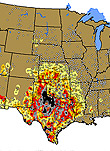U.S. scientists say the summer of 2011 was the nation’s second-warmest on record, with an average temperature of 74.5 degrees F from June through August — about 2.4 degrees higher than long-term averages — and with four states setting new summer records. Heat conditions were particularly blistering during August, with an average temperature of 75.7 degrees F, about 3 degrees warmer than the average between 1901 and 2000, according to the National Oceanic and Atmospheric Administration (NOAA). Across the southern U.S., record temperatures and below-average precipitation combined to create destructive drought conditions, with some areas experiencing a drought of greater intensity — though not yet duration — than during the 1930s and 1950s, according to the Palmer Hydrologic Drought Index. Meanwhile, states across the northeastern U.S. experienced wetter-than-normal conditions in August, with Hurricane Irene contributing to the wettest recorded Augusts for four states — New Jersey, New York, Vermont, and New Hampshire.
Second-Warmest U.S. Summer Recorded in 2011, Federal Agency Says
More From E360
-
Energy
Why U.S. Geothermal May Advance, Despite Political Headwinds
-
Food & Agriculture
In War Zones, a Race to Save Key Seeds Needed to Feed the World
-
Climate
Lightning Strikes the Arctic: What Will It Mean for the Far North?
-
RIVERS
A Win for Farmers and Tribes Brings New Hope to the Klamath
-
Solutions
Deconstructing Buildings: The Quest for New Life for Old Wood
-
NATURAL DEFENSES
How Restored Wetlands Can Protect Europe from Russian Invasion
-
Solutions
Birds vs. Wind Turbines: New Research Aims to Prevent Deaths
-
FORESTS
Cambodian Forest Defenders at Risk for Exposing Illegal Logging
-
OPINION
The ‘Green’ Aviation Fuel That Would Increase Carbon Emissions
-
CONSERVATION
Out of the Wild: How A.I. Is Transforming Conservation Science
-
Energy
China’s Mega Dam Project Poses Big Risks for Asia’s Grand Canyon
-
Solutions
How Natural Solutions Can Help Islands Survive Sea Level Rise
